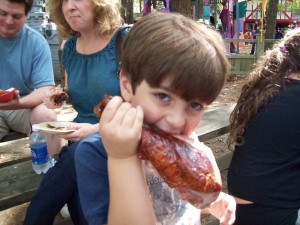Longtime readers often joke with me about the little carnivores I’m raising — L., in particular, is a lover of eating anything that at one time had a face. It’s true that while I enjoy eating vegetarian meals, it’s not a highly popular choice in this household. Moreover, I try to pay careful attention to my boys’ cues and how their overall health seems in making choices about our food, and they (again, particularly L.) seem to thrive best on diets that include pastured meat, rich egg yolks, and full-fat dairy.
Given these facts, and the fact that any dinner not including a recognizable animal protein is immediately met by a chorus of “Awwww! Where’s the meat tonight?” I wasn’t planning to push the idea of more meatless meals too hard. I thought we’d go gradually and try to sort of ease into the concept, until the kids presented me with a perfect opportunity to discuss the topic of meat.
We were eating some recent dinner — something with chicken, I can’t quite remember what — when five-year-old P. asked, very seriously, “How do they make chickens into meat?”
I almost choked. J. and I caught each other’s eyes across the table. This was a dilemma. Neither one of our children can be lied to, put off, or evaded in any way; they’re so reliable at detecting when we haven’t given them a full answer on even the smallest thing that I’ve considered lending them to the FBI for use in questioning witnesses. P. is particularly relentless in his pursuit of knowledge, and since L.’s insatiable curiosity has recently been mollified by learning to search the internet, I knew they’d team up to find out anything we might be trying to hide from them. Still, even though I knew that they were aware that the meat on our table each night was formerly a living creature, there were certain gory details I wasn’t entirely sure they were ready to hear.
“Chickens die and then they’re meat,” L. informed his brother with worldly seven-year-old importance.
P. shoved another bite of formerly-live-now-dead-and-therefore-meat chicken into his mouth and demanded, “But HOW? How do they do it?”
L. sighed. “Chickens get old and sick and then they die. Like people.”
I felt compelled at this point to intervene. “No, L. We don’t eat sick chickens. You wouldn’t want to eat chicken germs, would you?”
Both boys wrinkled their noses and let it be known how they felt about THAT prospect. P. calmly continued eating as he pestered me. “But if they’re not old, sick chickens, then how do they die and turn into meat?”
I thought of everything I knew about farming and poultry processing, and decided to give them as slimmed-down, but truthful, a version as I could. “Okay. So, when farmers have raised their chickens, and are ready for those chickens to become meat, they take them to a special kind of place that helps the farmers make their animals into food.”
“And they kill them?”
“Well. Yes. But they do it very quickly, and try not to make the chickens suffer. Then they take off the feathers —”
“And the faces,” L. provided, helpfully. “And the feet, right?”
“Yes, right. The feathers, and the faces, and the feet. And they clean out the inside parts of the chicken, and what’s left is what you guys are used to seeing when we bring chickens into the house.”
“Do they do it like that for cows and pigs, too?” L. wanted to know.
“Yes, it’s similar,” I said, ready to get off the topic, and amazed that both boys were still eating their chicken dinners with no apparent qualms.
“Poor chickens,” P. finally decided.
“Does it bother you to know that about your meat?” I asked them, noting just how un-bothered they appeared.
“No,” L. said. “I knew that already.”
“I didn’t,” P. said. “But it’s okay. I like to eat chicken. I just wouldn’t want to eat a chicken if it was my pet. You wouldn’t eat pet animals, would you?”
“Well, not exactly,” I said. “No, not pets. But the right kinds of farmers take really good care of their animals and treat them kindly, sort of the same way we would treat Merlin.” We all stared at our guinea pig, who squealed indignantly as if he understood what we were discussing. As I watched his whiskers twitch, I realized I was missing part of the teachable moment.
“You know,” I began carefully, “this is one reason why Mommy and Daddy always want us to be very thankful for the food that we eat, especially the meat on our plates. Not only have people worked hard to grow and raise that food for us, but we also try very hard to make sure that having a family that eats meat doesn’t mean that we don’t show respect to animals. We try to only buy meat from animals that were treated kindly and properly by their farmers when they were living, and to be grateful for that animal’s life when we have the chance to eat its meat. But this is why maybe we’ve been thinking that it would be good for our family, and good for the animals and the earth, to not eat quite as much meat as we have been. What would you guys think about that?”
“I think it’s good,” L. said.
“Me, too,” said P., who I swore had given up listening long before.
“So if we ate meals with less meat in them, maybe…two or three times a week? Would that be okay with you boys?”
“Sure,” L. said. “Pizza doesn’t have meat.”
We laughed and let the matter drop for the rest of dinner, surprised at how easily we’d gotten their buy-in. As J. started washing the dishes, P. came to me with a furrowed brow. “Does this mean you won’t ever make us chicken nuggets again?”
“No,” I assured him. “We’ll still eat the things you love. We might just also eat some other things that don’t come from animals.”
“Oh,” he said. “Then that’s okay. We must be thankful for the animals!”
It was that easy (though I was broken out in a cold sweat for most of the conversation) to introduce them to the tough concepts surrounding the food on their plates. What’s been harder, in general, is actually satisfying them with those theoretically well-received meatless meals. A winning dish recently was this Spinach and Mushroom Pappardelle, which disappeared with very little dinnertime fuss. Try it on your next Meatless Monday and see how your family enjoys it.



Leave A Comment